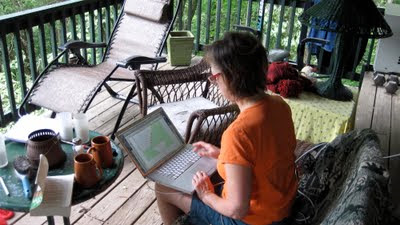I used to think that plants should be free, I liked to (and still do sometimes) thin them and give them away. I think I feel the same about some knitting patterns.
If there is nothing original about a pattern (such as a lace shawl with an old or commonly found pattern), why charge money for it?
After I went to Scotland, I decided that I'd like to put together traditional patterns in a way that I had seen at an evening of country dancing. The women wore skirts with vertical stripes, and triangular shawls to coordinate. I've done an amount of book and internet research, and this doesn't look like a traditional Scottish hap shawl, as they were square. They do look like hap shawls only done in a triangle, a "half hap" Joyce called it.
Even in Shetland on a cool summer evening, dancing is a hot business, so one can understand why they were wearing a "half hap." They were done in various lace patterns, often with an Old Shale border, sometimes with the border in different colors. But I couldn't find any patterns to knit with this feature. Decided to design one myself.
I decided that I liked the pine tree pattern with the old shale border. I knit one, and wrote out the directions as I knit. Here it is, unblocked
But in this day and age, one needs charts. Once I preferred knitting lace from text, now forget that. I looked around and priced computer resources for developing knitting charts, but didn't want to spend the bucks. Then I found some very useful internet resources on how to use Microsoft Excel to chart lace. Now, I've not used Excel except on one ill fated evening to try to plot out my monthly budget. That effort was quickly abandoned. This use of Excel looked to be much more fun.
Here are the sites I have used, many many thanks to the bloggers who have written up and shared their knowledge.
I set to work this June. Oh heavens, hours, hours, hours. It's addictive. Like when you've lost something and can't stop looking for it.
As a new designer, I've learning that graphing helps you to read the lace better, yet it can be confusing especially for triangles where new stitches come in at either side, and when matching up lace design elements correctly is critical. One wants what one is sharing if not selling to be correct. I've had to pull out the old shale several times to get both the knitting and the graph correct. And believe me, this is pretty easy lace.
Here it is pulled out last week
So, should patterns be free? Especially when using traditional design elements? I have decided perhaps not, especially when spending a thousand hours coming up with the graph. Now mind you, this has been a learning curve and I am definately still working on it. Another test version planned, with more colors.
Nevertheless, yes, it will be available for free, when done.
here are some photos of the ones I saw; if you see your back or knitting design here on my blog and object, email me and I'll remove the photo...but they are lovely and I want to share...



















